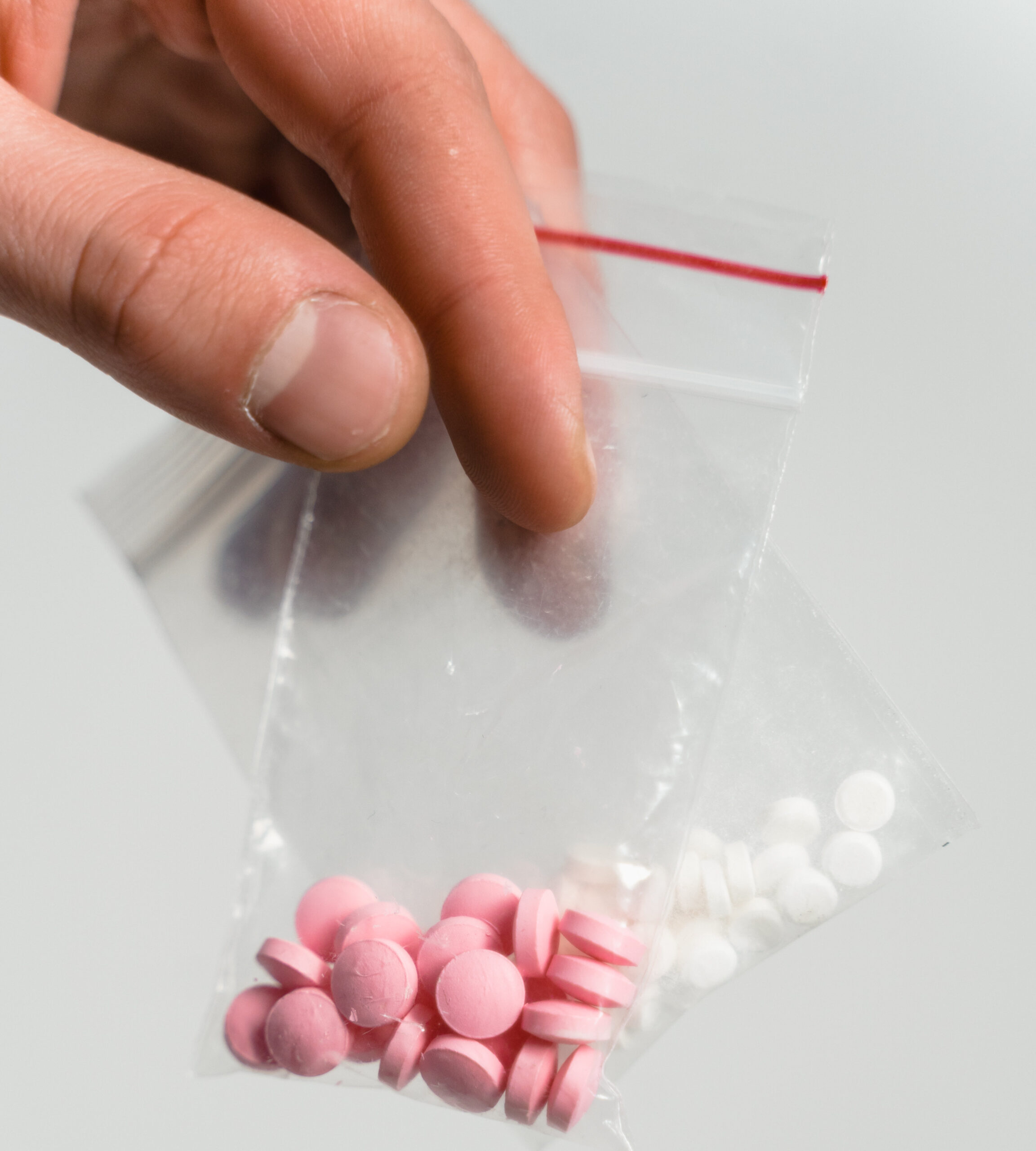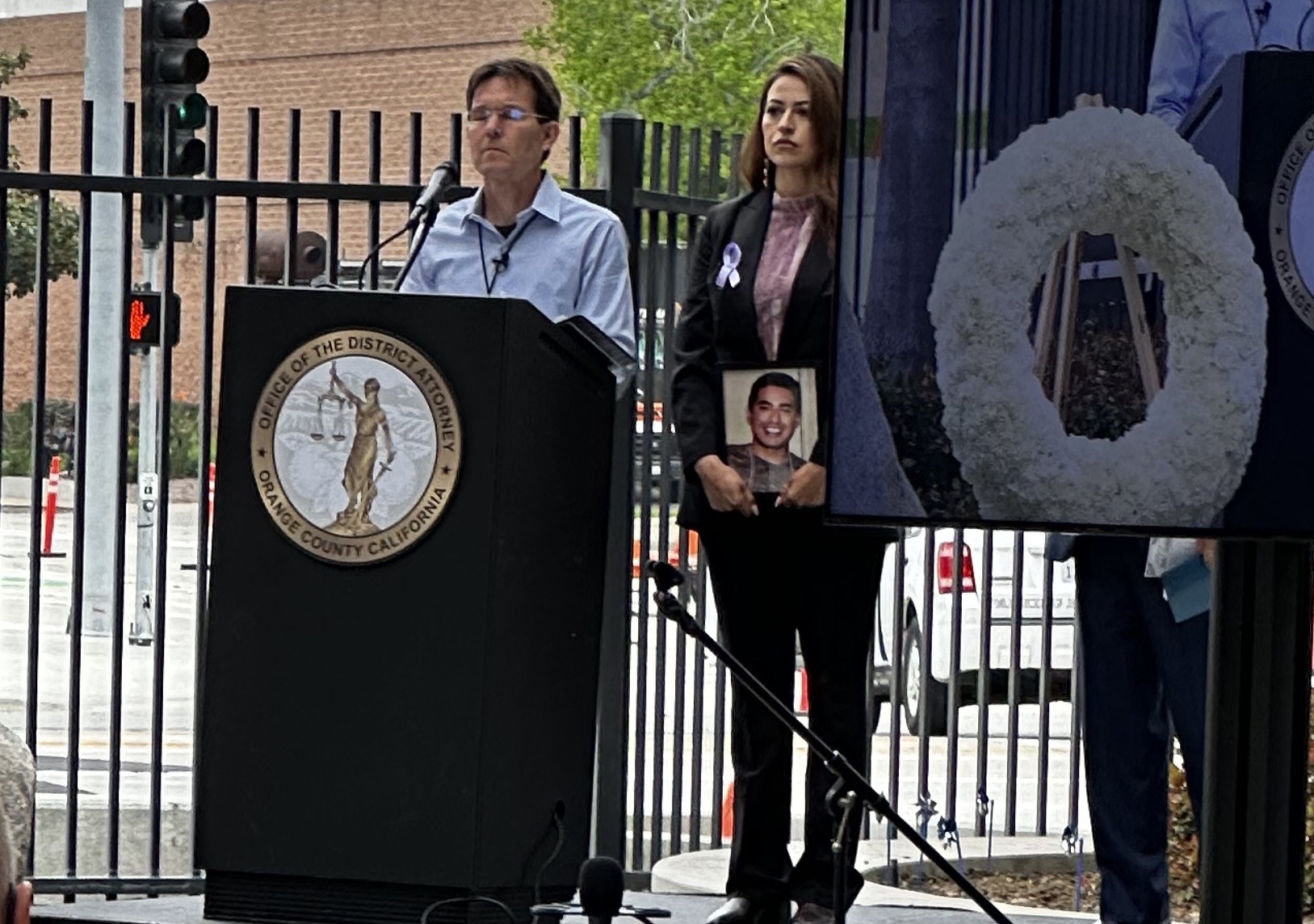The 2023 Orange County Crime Victims’ Ceremony was held in Santa Ana, California where there was a focus on fentanyl victims. The event was held to honor and remember those who have lost their lives as victims of crime. Many who attended the ceremony held photos of their lost loved ones and those honoring fentanyl victims wore lavender ribbons.
Matt Capelouto, whose daughter was murdered by a fentanyl dealer who sold her a counterfeit pill, spoke at the event and talked about how he wishes he didn’t have to be there. He expressed his frustration about bills getting stuck in committee in Sacramento and how the bill named after his daughter, Alexandra, aka SB44, would have passed on the house floor with 21 votes if it weren’t for partisan politics. He also announced FentanylSolution.org’s Poll-to-Prop initiative, which aims to take the vote to the people if legislators in Sacramento won’t do their job. Click the link here to view the video – https://youtube.com/shorts/wCycXyjau44.
Fentanyl is a potent synthetic opioid that has become a significant public health concern in recent years. Its impact has been devastating, leading to countless deaths and causing immeasurable pain to families and communities. The Orange County Crime Victims’ Ceremony serves as a reminder of the importance of addressing crime at large, including fentanyl, and the need for policy changes to prevent further harm.
FentanylSolution.org is an organization that is working to fight against the Fentanyl crisis. Through education, awareness, and advocacy, they hope to increase understanding of the dangers of Fentanyl and promote policy changes that focus on harm reduction and prevention. Our $2.2 million Poll-to-Prop ballot initiatives would give drug dealers longer prison sentences for murdering people with fentanyl. To donate to this initiative, email info@FentanylSolution.org for more information.



President Joe Biden’s drug czar has declared that the use of fentanyl mixed with Xylazine, an animal tranquilizer known as “tranq,” has become an emerging threat across the United States. The use of this drug combination has been linked to a sharp increase in overdose deaths, and the government is required to develop a federal plan to address the crisis. This declaration by Dr. Rahul Gupta, the director of the Office of National Drug Control Policy, marks the first time a presidential administration has formally labeled an illicit drug an “emerging threat” and then required the federal government to take further action.
What is fentanyl mixed with Xylazine, and why is it a problem?
Fentanyl is a powerful synthetic opioid that is often mixed with other drugs to increase its potency. Xylazine is a veterinary sedative approved for use in animals, but not for human use.

When mixed with fentanyl and sold on the illicit drug market, it has caused a sharp increase in overdose deaths across the United States. Xylazine, which is not an opioid, cannot be counteracted by the opioid overdose antidote, naloxone, in case of an overdose.The spread of Xylazine-laced fentanyl has exacerbated the nationwide addiction crisis, ravaging communities and deepening the toll of addiction.
Why is this an emerging threat?
The federal government has reported that overdose deaths involving Xylazine have risen in every region of the country in recent years. From 2020 to 2021, Xylazine-linked deaths increased more than 1,000% in the South, 750% in the West, and more than 500% in the Midwest, according to a DEA report (DEA Report). The Centers for Disease Control and Prevention found that 66% of drug poisoning deaths in the United States involve synthetic opioids like fentanyl (CDC).
What actions will the federal government take?
The declaration by Dr. Gupta requires the Biden administration to develop a federal plan to address the crisis. The government must publish a response plan within 90 days and send implementation guidance to agencies within 120 days, among other actions. The federal government will be mindful that Xylazine has legitimate uses in the veterinary profession and the agriculture industry while working on a whole-of-government response.
What are the dangers of ingesting xylazine?
Xylazine is not approved for human use, and ingesting it can cause serious, life-threatening effects, according to the Food and Drug Administration (FDA). People who inject it can develop flesh wounds, including blackened, rotting tissue (known as necrosis), which, if untreated, may result in amputation, according to the Drug Enforcement Administration (DEA).

In conclusion, the use of fentanyl mixed with Xylazine is an emerging threat facing the United States that has caused a sharp increase in overdose deaths. The federal government is required to develop a response plan to address this crisis, which includes evidence-based prevention, treatment, and supply reduction. It is important for parents to be aware of the dangers of drug use and to educate their children about the risks involved.
Grammy Award-winning rapper, Coolio’s cause of death has been revealed as a fentanyl overdose, according to a recent report by CNN and The New York Times. The rapper, whose real name is Artis Leon Ivey Jr., passed away on September 28, 2022, at the age of 59.

© Alex Valentovich / New Fury Media / Riot Fest Chicago 2022
The New York Times reported that Coolio had tested positive for fentanyl, a synthetic opioid that is 50 times more potent than heroin, 100 times more potent than morphine (CDC) and has been responsible for a surge in overdose deaths in recent years. The amount of fentanyl detected in Coolio’s system was small, but it was determined to be the cause of death, along with coronary artery disease.
Coolio rose to fame in the 90s with hits such as “Gangsta’s Paradise,” which won a Grammy for Best Rap Performance in 1996. He was also known for his appearances on reality shows such as “Celebrity Big Brother” and “Wife Swap.” His death was met with an outpouring of condolences from fans and fellow artists.

So many families including Coolio’s have suffered the loss of their loved ones. The revelation of Coolio’s fentanyl overdose highlights the ongoing opioid epidemic in the United States, where thousands of people die every year due to opioid-related overdoses (CDC).
Fountain Valley Officials Applaud Naloxone Program at Area SchoolsAt the first Fountain Valley mayor’s breakfast of the year, held on March 30 at Fountain Valley Regional Hospital in Orange County, California, several local issues were discussed, including a recently established drug program in schools. The program, which was initiated last November, aims to prevent overdoses in youth by placing drug stations with naloxone, a nasal spray that can reverse the effects of opioids, in schools. The program comes in response to the growing number of children overdosing on fentanyl across the state and country.
Why is this program important?
The opioid crisis has become a major concern in many communities, and youth are particularly vulnerable to its effects. Illicit drugs laced with fentanyl, a powerful synthetic opioid, are increasingly being sold to unsuspecting youth, often through social media platforms. This has led to a rise in overdoses among young people, including in schools. The drug program in Fountain Valley schools aims to address this issue and provide a timely response to overdoses, potentially saving lives.
What does the program involve?
The program involves placing naloxone stations in each elementary school, middle school, and high school in the Fountain Valley area. These stations are equipped with naloxone, a medication that can quickly reverse the effects of opioids and prevent overdose deaths. The naloxone is administered through a nasal spray, making it easy to use by school staff or other trained personnel in case of an emergency. The program was initiated by the Fountain Valley Fire Department and Emergency Medical Services teams, in collaboration with city officials.
Success of the program
Since its implementation, the program has already proven successful in saving a student’s life. In January, a student at Ocean High School who had taken an unknown substance bought off the street that was laced with fentanyl was administered naloxone by a teacher, according to Fountain Valley Fire Department Chief Bill McQuaid. The timely treatment with naloxone, also known as Narcan, saved her life, highlighting the importance of having naloxone stations in schools.

Why is this program necessary?
Lauren Lee, a former emergency room nurse who developed the plan for the school stations and currently serves as the Emergency Medical Services manager for the city fire department, emphasizes the importance of the program for student safety. She notes that a growing number of kids, including those in elementary school and older, are buying illicit drugs from dealers on social media sites, often through platforms like Snapchat. These drugs are sometimes misrepresented as harmless, such as marijuana gummies, when in fact they are laced with dangerous opioids like fentanyl. The presence of naloxone stations in schools can provide a crucial intervention in case of an overdose, potentially saving lives.
In conclusion, the drug program implemented in Fountain Valley schools to prevent overdoses in youth is a timely and important initiative. With the opioid crisis affecting communities across the country, it’s crucial to have measures in place to address the growing number of overdoses, including among young people. The presence of naloxone stations in schools can provide a lifeline in case of an overdose, potentially saving lives and protecting the well-being of students. As the program continues to be implemented and expanded, it is hoped that the need for naloxone stations in schools will decrease in the future, reflecting a reduction in overdoses and improved awareness about the dangers of opioids among youth. In the meantime, the program serves as a valuable resource to protect the health and safety of students in Fountain Valley schools. So far, the program has already demonstrated success in saving lives, and its continued implementation and expansion are critical in addressing the ongoing opioid crisis and protecting our youth.
Alexandra’s Law Fails in Senate Committee: What This Means for the Fentanyl EpidemicAlexandra’s Law Fails in Senate Committee: What This Means for the Fentanyl Epidemic
On Tuesday, Senate Bill SB 44, also known as Alexandra’s Law, failed to pass in the Senate Public Safety Committee. The bill, jointly authored by Senators Umberg & Ochoa Bogh, proposed implementing a fentanyl admonishment in California to address the growing opioid crisis.
The bill required issuing a written advisory or admonishment to a person convicted of a fentanyl-related drug offense, informing them of the dangers of manufacturing and distributing controlled substances, and potential criminal liability if someone dies due to their actions. However, the bill did not pass the committee, though it was granted reconsideration for a later hearing.
Why Is Alexandra’s Law So Important?
Fentanyl is an opioid 50-100 times more potent than morphine, with a rapid onset and short duration of action. It has become increasingly prevalent in street drugs and has been responsible for thousands of deaths across the U.S.
California alone accounts for approximately 11.5% of the 101,751 drug overdose deaths that occurred in the U.S. in the 12-month period ending in October 2022 (CDC).
The impact of fentanyl is devastating, with youth under age 24 accounting for the fastest rise in drug deaths. In California, a young person under 24 is dying from fentanyl every 12 hours. The biggest factor attributing to this danger is the undisclosed addition of fentanyl to other drugs, leading to fentanyl poisoning and death.
Fentanyl is the lead killer of teens in Orange County and of individuals between the ages of 18-45 in the U.S.
What Would Alexandra’s Law Do?
The proposed law would require an admonishment to be issued to anyone convicted of a fentanyl-related drug offense. This written advisory would inform them of the dangers of manufacturing and distributing controlled substances and potential criminal liability if another person dies due to their actions. The goal of the law is to hold predatory dealers accountable for the destruction they are causing and deter people from trafficking fentanyl.
What Are the Consequences of Failing to Pass Alexandra’s Law?
The failure to pass Alexandra’s Law is a significant blow to efforts to address the fentanyl epidemic. Without a comprehensive approach, it is challenging to curb the increase in fentanyl-related deaths. The bill’s authors and supporters believe that the fentanyl crisis requires a multifaceted approach, including education, law enforcement, and harm reduction angles, to tackle the issue comprehensively.

What Can We Do?
While the failure of Alexandra’s Law is disappointing, we can still take action to address the fentanyl epidemic. Here are some things we can do:
- Spread awareness: Educate yourself and others about the dangers of fentanyl and how to recognize the signs of an overdose.
- Advocate for change: Contact your representatives and urge them to support legislation to address the fentanyl epidemic.
- Get help: If you or someone you know is struggling with addiction, seek help from a healthcare professional or a support group.
The fentanyl epidemic is a growing problem that requires immediate action. While Alexandra’s Law may not have passed this time, we must continue to fight for solutions that will save lives and keep our communities safe.
FentanylSolution.org officially supported this bill with other important organizations such as the Association of Orange County Deputy Sheriffs, CA Coalition of School Safety Professionals, Drug Awareness Foundation, and California District Attorneys Association. The Mayors of Anaheim, Bakersfield, Corona, Irvine, Fontana, Fresno, Lake Elsinore, Murrieta, Menifee, Norco, Perris, Riverside, Sacramento, San Francisco, San Jose, Stockton and Temecula also showed their support.
In addition, our President and CEO, Janice M. Celeste, was in Sacramento at the California State Capital to support this bill and the parents who have lost a child to fentanyl poisoning.
Senate Holds Hearing on Illicit Fentanyl EpidemicOn February 15, 2023, the U.S. Senate convened a hearing on illicit fentanyl where a panel and lawmakers discussed the issue along with possible international strategies to combat the growing epidemic.
Along with a panel comprised of Anne Milgram, the Administrator of the Drug Enforcement Administration (DEA), Dr. Raul Gupta, the Director of the National Drug Control Policy, and Secretary Todd Robinson, the Assistant Secretary of State for International Narcotics and Law Enforcement Affairs, 14 senators from various states including, Ted Cruz (TX), Cory Booker (NJ), Tim Scott (SC), Jim Risch (ID), Chris Murphy (CT), Pete Ricketts (NE), Ben Cardin (MD), Bill Hagerty (TN), Jeanne Shaheen (NH), Tim Kaine (VA), Jeff Merkley (OR), Todd Young (IN) and Chris Van Holen (MD), and the chairman of the hearing, Bob Menendez (NJ) worked to get a grasp on the reasons behind the soaring overdose rates and ongoing fentanyl epidemic.
Milgram stated that in 2021, 100k Americans overdosed and that 70 percent of those overdoses were from fentanyl poisoning. She continued by saying that from August 2021 to August 2022, 107,735 American lives were lost to drug poisonings. At the end of last year, the DEA seized 57 million fake fentanyl pills, which was 13 thousand pounds of fentanyl that equaled 410 million deadly doses, according to Milgram. That is more than enough to kill every citizen in the United States and still have almost one million pills left over.
“From August 2021 to August 2022, 107,735 American lives were lost to drug poisonings.”
The head of the DEA also stated that social media is not doing enough to curb sales of fentanyl-laced pills, when young users can get access to drugs with just four to five clicks. She called social media a “superhighway for drugs.” Her testimony was poignant. When asked why the cartel would use deadly fentanyl in fake pills, she told the Senate that it’s to get their customers hooked since fentanyl is highly addictive, 50 times more addictive than heroin and 100 times more addictive than morphine. “If a user dies, it’s the cost of doing business,” Milgram said from the cartels’ point of view. If one person dies from a social media sale, there are millions more they can sell to, she said.
Closing the southern border was also discussed at the hearing since 90 percent of fentanyl is transported through ports of entry. That point was muted when Senator Booker quoted the Secretary of Homeland Security, Alejandro Mayorkas, who was not present at the hearing, as stating that almost all of the fentanyl seizures at the border were not trafficked by migrants, but by Americans. There was also a bipartisan push to put more pressure on China to do more to stop the import of materials used in making illicit fentanyl; and for Mexico to disband the two main cartels, the Sinaloa and the Jalisco, who make and distribute most of the fake fentanyl-laced pills that make their way into the United States.
You can watch the hearing, which is more than two-hours long, on C-Span, here Government Officials Testify on Fentanyl Trafficking | C-SPAN.org.


